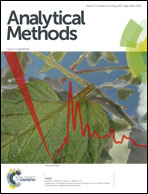Simultaneous detection of four nitrofuran metabolites in honey using high-throughput suspension array technology
Abstract
In this study, a new suspension array technology is proposed for the simultaneous quantitative detection of four major metabolites [3-amino-5-methylmorpholino-2-oxazolidinone (AMOZ), 3-amino-2-oxazolidinone (AOZ), semicarbazide (SEM), and 1-aminohydantoin (AHD)] of nitrofurans in honey samples. The analytes were coupled to bovine serum albumin before coupling to the microspheres. After coupling, a mixture of biotinylated antibodies specific for the four analytes, along with the analyte standard solutions or samples, was added to microtiter tubes. Then, the microtiter tubes were incubated at 37 °C for 45 min before streptavidin-R-phycoerythrin was added. Analyte residues were quantitatively analyzed by detecting the mean fluorescence intensity. The detection ranges for the four analytes were 0.02–40 μg kg−1 and the detection limit of AMOZ, AOZ, SEM, and AHD in honey samples were 0.087, 0.031, 0.055, and 0.131 μg kg−1, respectively. The recovery rates ranged from 76.6% to 106.1% for fortified samples at levels of 0.25, 1.0, 5.0, and 20 μg kg−1 with coefficient of variation values <15%. Finally, this method was compared to commercially available kits using fortified and ‘blind’ honey samples and the measurements obtained using these two methods correlated well. These results indicate that the suspension array method is suitable for detecting AMOZ, AOZ, SEM, and AHD, as well as other potential drug residues in animal tissues.


 Please wait while we load your content...
Please wait while we load your content...